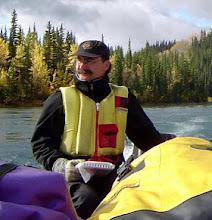 |
| The women's nail hammering competition. Frozen logs stiffly resist nails. |
The competitions had started and we pounded nails into logs, I wasn't the fastest but at least I got mine in straight, and later heard about the tea boiling and bannock making competition. The scene looked quite odd afterwards, all traces of activity being cleaned up by dogs and ravens leaving behind only seven or eight small burnt holes sunk through the white ice down to the charred remains of wood on the gravel. Looked like a series of meteorite strikes.
In the evening there was a feast, spagetti and meat sauce, baked salmon and moose stew. About half the town showed up for the dinner in the hall with small children and parents patiently lining up and chatting while we loaded plates with warm dinner. Later there was the annoucement of the winners of the Mr and Mrs Teslin contest (a couple in their thirties with five kids who run the hotel and restautrant and volunteer for everything) and a presentation by Alison, an MA student from an Alaskan University who spent the past 18 months working with the community on a cultural tourism plan. She had brought up a Chicken Dancer from the Siksika Reserve just outside of Calgary, her home town, and a storyteller from northern Saskatchewan. The feast and the entertainment were her thanks to the community for their support of her thesis research and a chance to present her findings. Things went reasonably well, the usual diversion form the "official" plan well within the norms of Yukon communities, but Alison remained somewhat tense throughout. It was her first "show" of this kind.
By the end of the dinner everything had gone well, the young chicken dancer performed a vigourous dance concluding with a breathless warning not to take up smoking, like he did, as it made it hard to dance. Alison's video couldn't be made to run on the computer so we skipped over that with a few words and then we all sang happy birthday to two of the Mr & Mrs Teslin children whose birthdays bracketed the feast day. Then everyone, except the dishwashers and table wipers, went next door to watch the hockey game in the just completed arena. We got a tour of the workout room with all its fancy equipment, heard about the challenges of scheduling things, some women don't like men to be in there while they're on the machines, and waded through a huge crowd of small children playing in the lounge. There was a 50-50 draw as a benefit for Rosss River, a nearby Dene community. Their arena and community centre burned down earlier in the week so there was some desolation up the CANOL Road. As people churned their pockets for coins and bills, half the money went into a large coffee can as the prize and the other half was meticulously taped onto a hockey stick that would be sent up to Ross River. It was a pretty amazing hockey stick by the end of the evening.
As we headed out to the car we ran into a concerned group standing around Alison and a group of locals in the lobby. Apparently while backing out her parking spot, Amanda tore the bumper off the front of the newly crowned Mrs Teslin's car. Amanda's experiences in community-based research was increasing expontentially. We headed outside, the wind had stopped, a cresent moon beamed through the mist and it started to snow.
 |
| The Anglican Church in old Teslin. |




.JPG)
.jpg)
















